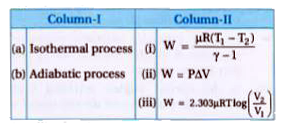Assertion: The heat supplied to a system is always equal to the increase in its internal energy.
Reason: When a system changes from one thermal equilibrium to another some heat is absorbed by it.Solution in Gujrati
Both assertion and reason are true and the reason is the correct explanation of the assertion.
Both assertion and reason are true but reason is not the correct explanation of the assertion
The assertion is true but reason is false.
Assertion and reason both are false.
The correct Answer is:D
Step by step video, text & image solution for Assertion: The heat supplied to a system is always equal to the increase in its internal energy. Reason: When a system changes from one thermal equilibrium to another some heat is absorbed by it. by Physics experts to help you in doubts & scoring excellent marks in Class 11 exams.
Topper's Solved these Questions
- BOOK - KUMAR PRAKASHANCHAPTER - THERMODYANMICS EXERCISE - Section-D Ncert Exemplar Solution (MCQs)6videos
THERMODYANMICS
- BOOK - KUMAR PRAKASHANCHAPTER - THERMODYANMICS EXERCISE - Section-D Ncert Exemplar Solution (MCQs More than one option )5videos
THERMODYANMICS
- BOOK - KUMAR PRAKASHANCHAPTER - THERMODYANMICS EXERCISE - Section-C (Objective Questions (Match))4videos
THERMODYANMICS
- BOOK - KUMAR PRAKASHANCHAPTER - THERMAL PROPERTIES OF MATTEREXERCISE - Question Paper (Section - D) (Answer following in brief :) Each carry 4 marks1videos
THERMAL PROPERTIES OF MATTER
- BOOK - KUMAR PRAKASHANCHAPTER - UNITS AND MEASUREMENTEXERCISE - Section -F (Questions from Module )20videos
UNITS AND MEASUREMENT
Similar Questions
An ideal gas undergoes four different processes from the same initial state as shown in figure of P-V diagram. Four processes are adiabatic, isothermal, isobaric and isochoric. Out of 1,2,3 and 4 which one is adiabatic ?
 01:18View Solution
01:18View SolutionWhich of the processes described below are irreversible ?
01:30View SolutionIn Column-I processes and in Column-II formulas of work are given. Match them appropriately :
 01:35View Solution
01:35View SolutionIn an experiment on the specific heat of a metal, a 0.20 kg block of the metal at 150∘C is dropped in a copper calorimeter (of water equivalent 0.025 kg) containing 150 cm3 of water at 27∘C. The final temperature is 40∘C. Compute the specific heat of the metal. If heat losses to the surroundings are not negligible, is your answer greater or smaller than the actual value for specific heat of the metal ?
02:46View SolutionIf the error in measurement of radius of a shpere is 2% then the error in determination of volume of the sphere will be …………
01:11View SolutionAssertion : First law of thermodynamics does not forbid flow of heat from lower temperature to higher temperature. Reason : Heat supplied to a system always equal to the increase in its internal energy.
01:02View SolutionAssertion: The heat supplied to a system is always equal to the increase in its internal energy Reason: when a system changes from one thermal equilibrium to another, some heat is absorbed by it.
03:01View SolutionIs the heat supplied to a system always equal to the increase in its internal energy?
06:30View SolutionWhen no heat is absorbed by the system them from the surroundings, but work (w) is done on the system, the change in internal energy of the system is given as
02:51View SolutionWhen work done by a system was 10J, the increase in the internal energy of the system was 30J. The heat 'q' supplied to the system was:
02:06View SolutionAssertion(A) : Two systems which are both in thermal equilibrium with the third system are in thermal equilibrium with one another. Reason(R ) : The heat flows spontaneously from a system at high temperature to a system at low temperature.
03:19View Solutionएक तन्त्र 400 J ऊष्मा को अवशोषित करता है एवं अपने परिवेश पर 150 J के समतुल्य करता है । तन्त्र की आंतरिक ऊर्जा में परिवर्तन की गणना कीजिए ।
01:45View Solutionदर्शाइए की स्थिर आयतन पर अवशोषित ऊष्मा तन्त्र की आन्तरिक ऊर्जा में वृद्धि के बराबर तथा स्थिर दाब पर अवशोषित ऊष्मा तन्त्र की एन्थैल्पी में वृद्धि के बराबर होती है ।
01:40View SolutionAssertion: If a gas is heated isothennally, then no part of the heat supplied is used to increase the internal energy.
Reason: Change in internal energy equals work done on the system.03:16View SolutionWhen is the heat supplied to a system equal to the increase in its internal energy?
02:21View Solution

